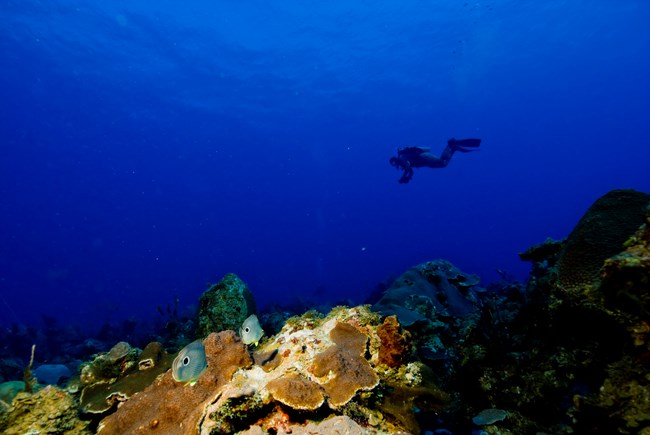
NPS Photo/Rob Waara
Temperature loggers are located at reef depth at a position generally representative of the site, typically at a centrally located coral reef monitoring transect pin. Most reefs are between 2-20m depth but can reach 30+m deep. Duplicate loggers are attached at the same point. The exception to this logger placement occurs at Salt River National Histoical Park and Ecological Reserve, which has the greatest range of depths of any of the sites. In this case 2 locations were selected, one at a deep location and the second at a shallower location to better capture potential temperature differences.
The three primary monitoring objectives for this vital sign are:
- Determine occurrence and duration of warm and cold water events that exceed thresholds known to cause stress (e.g., coral bleaching) to coral species for the purpose of interpreting trends in coral community metrics at sites established at Biscayne National Park, Buck Island Reef National Monument, Dry Tortugas National Park, Salt River National Historic Park and Ecological Reserve and Virgin Islands National Park.
- Determine the status and trends in water temperatures at reef depth at coral monitoring sites established in Biscayne National Park, Buck Island Reef National Monument, Dry Tortugas National Park, Salt River National Histoical Park and Ecological Reserve, and Virgin Islands National Park.
- Assess any correlations of warm water events and/or cold water events with coral bleaching and/or disease outbreaks at sites established at Biscayne National Park, Buck Island Reef National Monument, Dry Tortugas National Park, Salt River National Histoical Park and Ecological Reserve, and Virgin Islands National Park
Coral Reef Water Temperature publications
Find all monitoring reports, protocols, and resource briefs below.Source: NPS DataStore Saved Search 3522 (results presented are a subset). To search for additional information, visit the NPS DataStore.
Source: NPS DataStore Saved Search 3519 (results presented are a subset). To search for additional information, visit the NPS DataStore.
AQUARIUS Web Data Portal
Click the link below to search and view continuous water quality and quantity data from NPS monitoring locations within the South Florida/Caribbean Network.
AQWebPortal
Last updated: March 30, 2021
